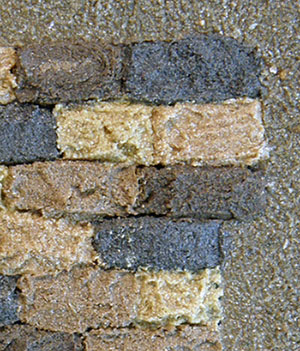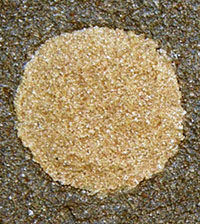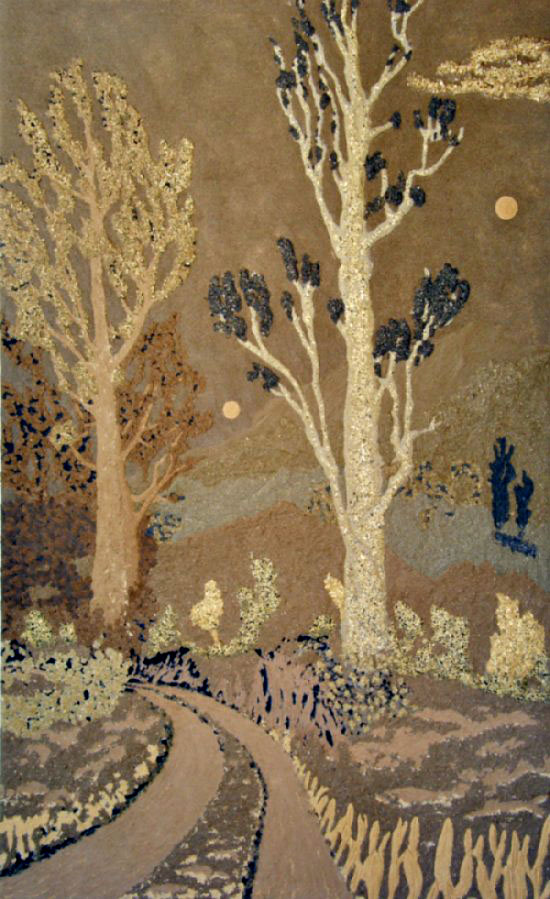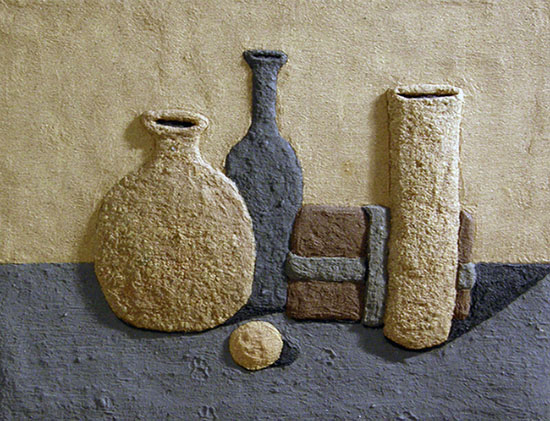Earth Tones
Today, we look at earth tones. The University of Houston's College of Engineering presents this series about the machines that make our civilization run, and the people whose ingenuity created them.
 We're in an exhibit of Wayne Gilbert's work -- called Blind Philosophy. Gilbert is fascinated by the playful ambiguities that lie along our winding trip from birth to death. There's a real zinger in the exhibit, but first, look around at the pictures. They're done in a vast array of earth tones -- ivory, tan, brown, almost to black. And they're wonderfully calming. The texture of these fanciful commentaries on life, love, and the pursuit of happiness draw us in. We're reminded of sandy beaches, limestone caves, sand dunes -- of whetstones and cat tongues -- of Zion National Park. Well we should be ...
We're in an exhibit of Wayne Gilbert's work -- called Blind Philosophy. Gilbert is fascinated by the playful ambiguities that lie along our winding trip from birth to death. There's a real zinger in the exhibit, but first, look around at the pictures. They're done in a vast array of earth tones -- ivory, tan, brown, almost to black. And they're wonderfully calming. The texture of these fanciful commentaries on life, love, and the pursuit of happiness draw us in. We're reminded of sandy beaches, limestone caves, sand dunes -- of whetstones and cat tongues -- of Zion National Park. Well we should be ...
For the zinger is that these pictures are made from funerary ashes -- mostly remains that were abandoned at crematoriums. Each of us leaves behind remains of different hues. And, as Gilbert sifts each set of ashes for fineness, they sort into additional colors. So what images does Gilbert form from them?
 Here's a landscape, a road leads into an evening forest lit by two moons. Why two? Well, one is your moon, the other mine. As we look at another image, five links of chain, we realize that our afterimages are linked in this world, just as our lives were also once linked. Did you know that, every time we breathe, we inhale an atom or two of every person who has ever rejoined the earth?
Here's a landscape, a road leads into an evening forest lit by two moons. Why two? Well, one is your moon, the other mine. As we look at another image, five links of chain, we realize that our afterimages are linked in this world, just as our lives were also once linked. Did you know that, every time we breathe, we inhale an atom or two of every person who has ever rejoined the earth?
One image is arresting: The khaki-colored left side has the barely perceptible numerals 9/10 embossed upon it. But colorful numerals six feet high, proclaim 9/11 on the right. The title is The Difference a Day Makes.That sent me off to look at statistics, and I found that the death toll in the terrorist attacks accounted for a scant two percent of world-wide deaths on that day.
Not to trivialize individual loss, but we need to remember the universal cycle we're all part of. If these people linger to bring some beauty and calm to us this afternoon, how much more do they linger in the world they built and passed on to us?

Out of gratitude to the individuals, Gilbert writes their names on the back of each canvas, but he will not make individual memorials. If he did, this would have the same terminal quality of a graveyard. Instead, he asks us to remember how far the gratification of living outweighs the inevitability of death.
So we turn back to the pictures. Four pieces of a jigsaw puzzle, titled Puzzled-- a triangle with eight horizontal bars in graduated earth tones titled 8 of My Friends: Our link with past friends is a puzzle indeed. One still life shows an array of clay vessels, and it reminds me of a Mexican folk song,
Friend, when I am dead,
Make a cup of the clay I become
And, if you remember me, drink from it.
These images left me far more at ease with our ever-present swirl of troubles -- and so much better equipped to savor the huge gift of life that is, for a while, ours to enjoy.
I'm John Lienhard, at the University of Houston, where we're interested in the way inventive minds work.
W. Gilbert, Blind Philosophy: Works by Wayne Gilbert. (Houston, TX: Classic Printers, Inc., 2007): Catalog of the show Blind Philosophy at the Art League of Houston, Oct. 25 to Jan. 1, 2007. My thanks to Mr. Gilbert for his permission for this one-time use of the images on this page. Photos by JHL.

The Road Home (Landscape with 2 Moons -- Mine & Yours) 2006/7

People in the Manner of Giorgio Morandi 2003
Friend, when I am dead,
Make a cup of the clay I become
And, if you remember me, drink from it.
Should your lips cling to the cup
It will be but my earthly kiss.